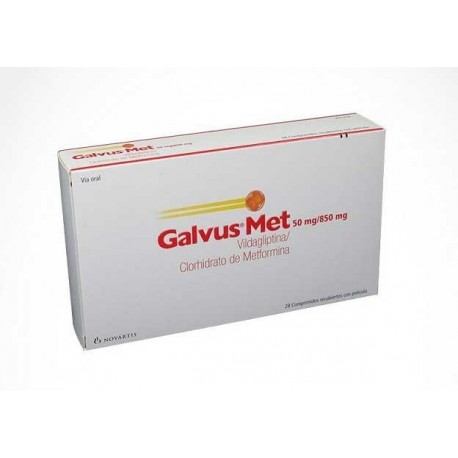Volume discounts
| Quantity | Discount | You Save |
|---|---|---|
| 2 | 5% | Up to $4.90 |
| 3 | 10% | Up to $14.70 |
| 4 | 15% | Up to $29.40 |
| 5 | 20% | Up to $49.00 |
More info
1. What GALVUS is and what it is used for
GALVUS belongs to a group of medicines called oral blood sugar lowering medicines.
GALVUS is presented in aluminum blister packs containing 28, 56 and 180 tablets. Each tablet contains 50 mg of vildagliptin active ingredient.
GALVUS is a medicine used in the treatment of diabetes (Type 2 diabetes) that cannot be controlled by diet and exercise alone. It helps to control blood sugar level.
Diabetes (Type 2 diabetes) develops when your body does not produce enough insulin or when the insulin produced does not work properly. The disease can also develop when too much of a hormone called glucagon is produced.
Insulin is a substance that helps lower the level of sugar in your blood, especially after meals. Glucagon is a substance that triggers sugar production in the liver, causing blood sugar levels to rise. Both of these substances are produced by the pancreas.
GALVUS causes the pancreas to produce more insulin and less glucagon. In this way, it helps to keep the blood sugar level under control.
Your doctor will prescribe GALVUS for use in combination with another blood sugar lowering medicine if your blood sugar level cannot be controlled by a medicine used alone.
2.How to use GALVUS?
Instructions for proper use and dose/frequency of administration
The dose of GALVUS to be used varies depending on the patient's condition. Your doctor will tell you exactly how many tablets of GALVUS you should take.
Generally used dose of GALVUS:
If you are taking GALVUS with another medicine called a sulfonylurea, 50 mg once a day in the morning, or
GALVUS alone, together with metformin or another medicine called glitazone, metformin
and if you are using a sulfonylurea or in combination with insulin, 100 mg daily, 50 mg in the morning and 50 mg in the evening
If you have moderate or severe kidney disease or are on dialysis, 50 mg once daily in the morning
Keep using GALVUS every day for as long as your doctor tells you to use it. You may need to continue this treatment for a long time. Your doctor will monitor your condition regularly to check whether the treatment is working for you.
Do not stop using GALVUS unless your doctor tells you to.
Do not forget to take your medicine on time.
If you have questions about how long to use GALVUS, ask your doctor.
Application route and method
GALVUS is for oral use only.
Swallow the tablets whole with a glass of water. Tablets should not be chewed, crushed or divided.
GALVUS can be taken on an empty or full stomach.
3. What are the possible side effects?
Like all medicines, there may be side effects in people who are sensitive to the substances contained in GALVUS.
Side effects are listed as shown in the following categories:
Very common: may occur in more than 1 in 10 patients.
Common: less than 1 in 10 patients, but more than 1 in 100 patients.
Uncommon: less than 1 in 100 patients, but more than 1 in 1,000 patients.
Rare: less than 1 in 1,000 but more than 1 in 10,000 patients
visible.
Very rare: less than 1 in 10,000 patients.
Not known: It can be seen in too few patients to be determined with the available data.
Some medical symptoms that need immediate attention:
GALVUS alone or in combination with another drug (metformin or sulfonylurea group)
Side effects that may occur when using (combination):
Rare:
Swelling of the face, tongue or throat, difficulty swallowing, difficulty breathing, sudden onset of rash or hives, which may indicate a serious allergic reaction called angioedema
Yellow color of the eyes and/or skin, nausea, loss of appetite, or darkening of the urine, indicating liver disease (hepatitis)
Severe upper abdominal pain (possible sign of inflamed pancreas)
Headache, somnolence, weakness, drowsiness, confusion, irritability, hunger, fast heart rate, sweating, feeling irritable (possible symptoms of low blood sugar called 'hypoglycemia')
If these symptoms appear, please stop taking GALVUS and talk to your doctor.
Side effects that may occur when GALVUS and metformin are used together:
Widespread:
Shake
Headache
drowsiness
Nausea
Decreased blood glucose Uncommon:


